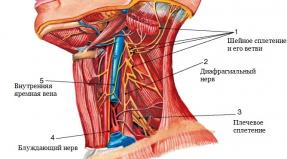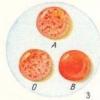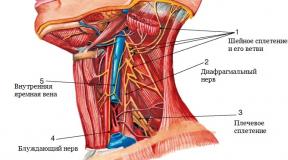How to paint a Zhostovo tray: stages of painting, a master class for beginners. Zhostovo painting on trays Patterns of Zhostovo painting
Master class with a step-by-step photo "Elements of Zhostovo painting"
Author of the work: Shakleina Irina Yuryevna, educator of MADOU CRR, d/s No. 110 Kaliningrad region Kaliningrad city.This material will be useful for preschool teachers in their work on introducing children of senior preschool age with Zhostovo painting, for parents.
Target: acquaintance of children with the features of the painting of the Zhostovo craft.
Tasks:
- to cultivate love and respect for folk craftsmen, pride in their people;
- allocate means of artistic expressiveness: pattern elements, color, composition;
- to fix the techniques of drawing with a brush: with the end of the brush, with the whole brush, perform a double stroke when depicting buds, flowers and leaves;
Materials and tools:
- landscape sheets tinted with black (blue, green) gouache or ink, or black (blue, green) paper from the Colored Paper set, or cardboard (the shape of the paper depends on the shape of the trays - round, oval, rectangular);
- gouache;
- brushes for drawing (squirrel or kolinsky, No. 2, No. 4, 5);
- palette;
- jar for water;
- a rag for a brush;
- cotton buds.
Zhostovo painting is a Russian folk craft of artistic painting of forged metal (tin) trays, which has existed since 1825 in the village of Zhostovo, Mytishchi district, Moscow region. The tiny village of Zhostovo is world famous for its trays of gorgeous flower bouquets. Together with Khokhloma and Gzhel, trays with floral ornaments have become a real hallmark of our country, embodying Russian folk crafts, and are recognizable far beyond the borders of Russia. By purpose, the trays are divided into two groups: for domestic purposes (for samovars, for serving food) and as decoration.
Painting is usually done on a black background (sometimes on red, blue, green, silver), painting is carried out without transferring the drawing to the surface.
The main motif of the painting is a flower bouquet, in which large garden and small wild flowers, leaves, buds and stems alternate. The center of the bouquet are images of large flowers: poppy, rose, dahlia or aster. Wildflowers are introduced into the drawing as elements that complement and enrich the composition.
The bouquet may be placed in the center of the tray, in which case one speaks of a collected bouquet.
If flowers and leaves are located along the edges of the tray, they talk about a wreath.


Elements of Zhostovo painting are depicted in several stages:
- painting (the beginning and basis of the composition of the future pattern, i.e. the silhouettes of flowers and leaves in accordance with their plan);
- tenezhka (the word "tenezhka" is consonant with the word "shadow". Flowers have volume, shady places of plants are indicated);
- laying (one of the most important stages of painting. The shape of the bouquet takes on flesh - many details are clarified, a contrasting or more harmonious structure of the entire composition is highlighted and realized);
- glare (imposition of glare reveals light and volume. The bouquet seems to be illuminated. Glare creates mood and color).
- drawing (this is the final part of the work. Using a special thin brush, the artist applies small but very significant strokes - veins and lacy edges on the leaves, "seeds" in the center of the cups of flowers);
- binding (with the help of thin stems, blades of grass and tendrils, the bouquet is formed into a single whole and connected with the background).
- cleaning the edges of the tray (decoration of the side of the tray, consisting of geometric or floral patterns. Cleaning can be modest, or it can compete with luxurious antique picture frames. Without cleaning, the product looks unfinished).
This is a very long and complicated process.
Acquaintance of preschoolers with Zhostovo painting takes place in the senior and preparatory groups. The whole process of step-by-step creation of a flower arrangement is difficult for preschoolers to depict. I want to bring to your attention a lightweight version available for preschoolers, which I use in my work with older preschoolers.
To make the strokes beautiful, neat, round squirrel and kolinsky brushes are used in brush painting. If you don’t have these, then use a brush with a thin tip of the pile for painting.
Master class progress:
Let's start with the image of large flowers.
He looks down on you
You will not find a prouder flower.
He is the lord in the autumn garden,
This is a bright color ... (dahlia).
This is how real dahlias look, pleasing our eyes with their beauty in the autumn garden.
Dahlias are luxurious plants with a long flowering period.
According to one of the legends, dahlias used to grow only in the royal garden and were protected like the apple of an eye. Once a young gardener stole a flower and planted it under the window of his beloved. The gardener was thrown into prison, but the flower ceased to be a wonderful secret and became available to ordinary people.
According to another legend, the dahlia grew when the earth thawed after the ice age, at the site of the last fire that died out. Her appearance has become a kind of symbol of the victory of life and the beginning of a new era.
Today, there are thousands of varieties of dahlias and several types of their classification.


Before drawing dahlias with children, you can sketch the future flower with a simple pencil in the form of a circle. Dahlias are depicted using the "double stroke" brush stroke technique. A double stroke helps to convey both color and shade. We choose a color solution for our future flower. For example, red and yellow. We lower the brush into the yellow paint, remove the excess paint on the edge of the jar, pick up red paint on the tip of the brush and, by dipping, make strokes along the edge of our sketch in a certain sequence: top-bottom, right-left.

If the paint is over, then we wash the brush and pick up the paint again: first - yellow, on the tip of the brush - red paint. We continue to draw the petals of our dahlia.


In the same sequence, fill the second row of petals.



And now with light strokes we fill the middle of the flower. Here we have such a handsome man.

And this is a dahlia in a different color scheme.

head on leg,
Peas in the head.
The sun burns the crown,
Wants to make a rattle (poppy).
Blooming poppy is a symbol of unprecedented beauty, unfading youth and feminine charm.

I propose the following sequence of the image of the poppy.



A poppy bud can be depicted as follows.

There is a curl in the garden -
White shirt,
Golden heart.
What it is? (chamomile).
Chamomile is one of the most recognizable and dear to our heart flowers. Wreaths are woven from it, they are collected in bouquets, girls are guessing on it: “Loves - does not love”, and even look for answers to cherished questions: “Yes, no, it will definitely come true, it’s better not to do it.” There are legends about many flowers, including chamomile.
Long ago, in a small lost village, there grew up a beautiful girl with blond hair, sky blue eyes, and radiant sunny skin. The girl also had a lover - a young man Roman from the village next door. The couple spent all the time together, walking through the forests, meadows, picking flowers and berries. One night, Roman had a strange dream - a wise man gave him an amazing flower - with a yellow core and white petals around. In the morning, waking up, Roman saw a flower from a dream on his bed. In life, the flower was even more beautiful than in a dream. Roman gave it to his beloved, who called the flower a gentle name - Chamomile.
As the myth about the flower says, the lovers admired the beautiful chamomile, and one day the girl asked Roman to return to the land of dreams to collect a huge bouquet of daisies and give it to people. Roman went on a long journey, for several years he wandered through distant countries and, finally, at the very end of the world, he found the kingdom of sleep. The king offered to give Roman a whole field of daisies in exchange for the fact that the young man would forever remain in his possessions and would not return home. Roman for the sake of his beloved agreed to everything and remained in the realm of dreams. A beautiful girl waited a long time for his return, and one morning near the house she discovered a field of beautiful daisies. She guessed that Roman was alive and loved her, but they could not be together. Since then, chamomile has been considered a symbol of lovers.

For the image of the daisy, we again use the "double stroke" brush stroke technique. We collect white paint on the brush, and blue or blue paint on the tip of the brush. The tip of the brush always points to the center. We draw the petals in the following sequence: vertically above - below, horizontally on the right - on the left, strictly in the middle in the gaps formed.

Now we will draw small flowers that help to complement and enrich the composition.
Leaf - shamrock, like a fan,
Thin, flexible stem
Red hat - flower.
Sweet juice in those flowers.
A bumblebee flies after him to ... (clover).
The name trifolium means "having three leaves". Shamrock, Clover, Kashka. There are many legends around the clover - shamrock, of course, the most famous legend is about the fourth leaf. Finding such a four-leaf clover is considered incredible luck.
The most famous clover myth is that Saint Patrick used three leaves on one stem to explain the concept of the Holy Trinity - the leaves depicted God the Father, God the Son, and God the Holy Spirit. It is also believed that with the help of a clover leaf, Patrick expelled all the snakes from the settlements where he was. Indeed, it is believed that where clover grows, snakes never crawl. Perhaps for this reason, the clover, or shamrock, is a symbol of Ireland.

To draw a clover flower, we need to mix paints - fuchsia and white. Get a gentle shade. We draw a circle with a pale pink color, then with the tip of the brush we pick up fuchsia-colored paint and draw small strokes in a certain sequence (the first row of strokes is at the bottom of the flower, a little higher is the second row of strokes, and the last row is at the top of the flower). We draw the petals of our clover with green paint using the “sticking” technique (you can draw either three petals or four)

This blue flower
Reminds us of you
About the sky - pure, pure,
And the sun is radiant! (forget-me-nots).
There are various legends about the origin of forget-me-nots, often very similar to each other. They talk about the tears shed by the brides when parting with their loved ones. These tears turn into blue, like their eyes, flowers, and the girls give them to their lover as a keepsake... One legend about forget-me-not says that the goddess Flora, giving names to different plants, ignored a modest blue flower. Already leaving, she heard this flower quietly say: "Do not forget about me!". Flora saw the flower and named it forget-me-not, giving it the ability to evoke memories for people.

When depicting forget-me-nots, you can use cotton swabs.

Now let's move on to the image of leaves, grass. Here you need to practice a little in scrolling the brush clockwise with your fingers. Scrolling can be done very small, with the help of scrolling the brush, the leaves are obtained as if in motion, slightly with curved tips. For the image of all the leaves, we also use the "double stroke" technique to convey color and shade. First we collect green paint, on the tip of the brush - yellow paint.

We depict these large long leaves with a “zigzag” stroke - the tip, the entire brush, the tip, scrolling the brush with your fingers.

To make it easier to draw the leaves of dahlias, roses, you can first draw an approximate outline of the leaf with a pencil. The first stroke is always done in the middle. This stroke is called "zigzag" - the tip, the whole brush, the tip. Then sequentially fill the body of the leaflet.
Zhostovo painting is a Russian folk art, defined in the painting of metal trays. The coloring has something in common with the Tagil painting, although, in fact, it is a late offshoot from it by the beginning of the 19th century.
The first independent workshop was created around 1825 by Osip Vishnyakov in the village of Zhostovo in the Moscow region. He was engaged in the manufacture of papier-mâché and metal spacing with the use of varnishes, and along with him there was a workshop for “remaking trays” by Ivan Mitrofanov. Along the chain, new workshops began to open. The tray-making industry has had its ups and downs. The fact is that with the advent of Soviet foundations, the drawings were often simplified, which did not have a very good effect on the works themselves, because the masters were required to repeat the style of the ornament, which was not the principle of this particular applied art. Now the situation remains at a stable level.
To this day, mass production of trays painted with this technique is being carried out; in modern art, the old traditions of ancient crafts are more often supported and developed. It is not surprising that the painting of trays from Zhostovo flourishes, since the painting technique created over the years truly fascinates with voluminous masterpieces.


Characteristic features
Decorative painting of trays with Zhostovo motifs is magnificent flower bouquets, most often on a black or red background. The technique is accompanied by complete improvisation, mostly large loose flowers and broad leaves. Flowers do not repeat exactly as in nature, but have the basic structure of a natural flower, thereby creating a line between reality and fiction, adding more tenderness and brightness to flower bouquets. Less common, but still there are birds and animals, as well as silhouettes of dishes and people.
In ancient times, gold and silver colors prevailed, now the works have gained bright colors.
Steel is used to make trays. Before painting, the product must be prepared for work. Ground is applied to the trays, sanded, varnished in black several times. Dry each layer.

Composition drawing technique
What draw such a miracle? For painting, they use materials such as oil-based paints, natural brushes, gold paste, a blank metal tray, varnish, linseed oil for correcting mistakes, and related tools - a glass for water, a ruler and a palette for mixing paints.
The drawing is applied directly to the background in stages. The compositions can be bouquets or placed along the edges of the tray. How to draw and what colors can be used? Many colors are used in Zhostovo painting, mostly red, pink, blue, green, and white and black colors will definitely be needed to complete the picture, giving volume to the petals.
The first stage of work will be the so-called "painting". Wide strokes of the main flowers are used, this is the basis for future flowers and leaves.

Then shadows are drawn with a brown or darker shade, at the same time, on the other hand, we highlight with a lighter shade. Photo below.



Here is another photo of color options that can be included in the work. Colors vary by the master, depending on the wishes. The drawing does not end there, there is still a lot of work, because this type of painting should look voluminous and colorful. In the future, glare, shading on the leaves and on the background, veins and openwork edges are applied. The most responsible step in the work - "pad": dense body letter. Bouquet forms take on flesh, are accentuated, brightened, a contrasting or more harmonious color system of the entire composition is realized. With the help of thin strokes, the composition is collected into a single bouquet. The tray at the end of the work is framed with geometric patterns in gold and white paint.


The style of Zhostovo trays will perfectly complement the decor of the kitchen, it just looks chic and can be presented as a souvenir to friends from other countries. Table setting with such trays will add color and warmth to any home. Pictures of trays with red and other backgrounds with a predominance of gold designs.



If you learn how to draw with Zhostovo painting correctly, then the pictures will turn out very quickly.
So, the masters who have mastered this art can decorate more than one tray in one day. The artist immediately works with paint, without preliminary sketches. The master constantly turns the tray, which makes such drawings more lively and mobile.
This painting technique is used when painting wooden and metal objects. Zhostovo painting consists of a variety of images of flowers, which are collected in the most beautiful compositions of bouquets.
For children, the lessons of Zhostovo painting are very useful, as they help develop imaginative thinking, an eye, the ability to use a brush and make a variety of strokes. It is almost impossible to learn this in one lesson, since you need a phased study of the technique of making strokes to depict one or another element.
Where to begin
Zhostovo painting requires the preparation of the necessary tools. For training, a landscape sheet of paper is ideal. You can practice on wood or metal after the acquired skills and knowledge. For the first lessons, prepare the following inventory:
- album sheets for drawing;
- jar gouache;
- round squirrel pussies of different thicknesses;
- a jar of water;
- palette for mixing paints;
- soft cloth made of natural fabric for wiping and dipping paints from brushes.
The ABC of brush strokes
The first thing you need to learn is the strokes that make up the Zhostovo painting. They are different, so each of them requires its own explanation of implementation.
- Flat smear - begins with a sweep of the entire pile, which rises sharply from the middle. It is better for him to use a brush under number 6. You need to practice making a flat stroke in different directions. If you connect several of these elements, you get a "crown", which is used to depict a flower.
- Stroke "Droplet" - the brush is placed vertically, pressed to the middle and moved down, draw the second stroke, placing it side by side. The result is a heart, which is also used as flower petals.
- The “Droplet” brushstroke is very similar in technique to the flat brushstroke technique, but towards the end, its swirling part turns to the left or right.
- "Zigzag" is actively used if you need to frame a tray or a picture. The image starts from the tip of the brush, and as it goes down to the middle, and then goes in reverse order to the tip. Using the connection of two "zigzags" together, a "stalk" is obtained.
One stroke can depict two colors at once. To do this, the brush is dipped in different paints, and the excess is removed with a cloth. Thus, all of the above strokes are practiced with children.
Practice drawing all the elements and combining them into buds, flowers, leaves.
Technology features
It should be noted that the liveliness of the drawings gives their heterogeneity. Therefore, when children learn how to depict the main elements, they should be taught how to gradually apply colors to the picture. This will bring the image to life.

Zhostovo painting for children takes place in two stages. At the first, the so-called "painting" is done. This is a kind of outline where the flowers of the future bouquet will be located. After drying, a “shade” of the pattern is made.
Explain to the children that dark shades are applied first, and then light ones. This is the whole technique of drawing.
Only after the child succeeds in accurately making painting elements and composing flower arrangements on paper from them, can one try to paint a tray, mugs, plates and other objects.
Decorative and applied art of the peoples of Russia is the hallmark of our country. Among folk crafts, Zhostovo painting occupies a special place, striking with the freshness of flower arrangements, as well as the purity and tenderness of the color scheme.
Development area
Zhostovo painting got its name from the place of origin and production. Metal trays painted with floral arrangements originated in the Moscow region. Their homeland was the village of Zhostovo near Mytishchi.
The forerunners of Zhostovo painting were paintings on trays, which arose in the middle of the 18th century in the Urals, not far from the location of the famous Demidov factories. Only in the first quarter of the 19th century, the former serfs, the Vishnyakov brothers, who had bought themselves out of dependence, and who had accumulated a small amount of capital, opened their workshop in the village of Zhostovo. A little later, fishing began to develop in other villages near Moscow. Gradually, the Zhostovo workshop became the leader in the industry.
The Vishnyakovs were miniaturists, and therefore painted not only trays, but also caskets, cigarette cases, tea caddies, albums and other household items. Osip Vishnyakov went to sell goods in Moscow and gradually saved up money for which he was able to rent a shop on Tsvetnoy Boulevard. A special demand for Vishnyakov's trays arose with the spread of tea drinking traditions in Russia. They were used as pallets for samovars.
At the beginning of the 20th century, interest in folk crafts fell, and therefore, at the end of the 30s, scattered artels in neighboring villages and in Zhostovo had to unite. As a result, a whole factory for decorative painting of metal trays was opened - "Metal tray". And since 1960, the Zhostovo factory of decorative painting saw the light.
Stages of product creation
From the beginning to the end of the manufacture of the product, the process of creating Zhostovo painting goes through a number of stages:
- Production of a tray of oval, octagonal, round, rectangular or combined shape.
- Priming the surface of the workpiece.
- Irregularity patching.
- Leveling the surface of the base to a smooth state.
- Varnish coating.
- Painting with oil paints.
- Two-layer coating of the product with a transparent varnish.
Features of the manufacture of the base
Usually the base-tray is forged by hand from sheet iron, for which good quality roofing steel is used. The sheets are first stamped and then rolled to make the boards hard. In the manufacture of standard-shaped trays, large iron sheets are cut into blanks of the required shape and size. Then, on an electric press, the "cutting" and "pulling" of the tray takes place. With the help of molds and a combined stamp, the sides of the future tray are formed. This process is called "boarding" or "rolling".
Stage-by-stage painting of the Zhostovo tray
Here's how it all goes:
- At the priming stage, a background is selected and applied - the color of the tray. Usually it is black, but there are products with a blue, red, green background. Oil varnish is traditionally used to create a black background. The secret of the varnish has been lost, but its base is known - a palm resin from Africa called copal. Due to the special lacquer composition, the trays were extremely durable. According to the old masters of Zhostovo painting, their products are not afraid of either frost or heat and can only be compared with Chinese ones. At that time, this comparison assumed the highest quality of the goods.
- At the second stage of the Zhostovo painting, painting is created - the general silhouettes of the drawing are made with diluted paint and fired in a special oven for several hours. For painting and background, the craftsmen use ordinary oil paint, diluted with linseed oil or turpentine, and a wide brush. When the master writes out his bouquet, he usually rotates the tray, substituting the brush under the desired area.
- Shade is a stage at which shadows are also applied to the silhouettes with diluted paint to create the primary volume.
- The laying stage is the most important in painting. It is here that the volume is given to the drawing, accents and highlights are applied by means of white space. Details are being specified.
- At the glare stage, light reflections are applied, the image seems to be illuminated from different sides by several light sources.
- At the drawing stage, important small elements of the drawing are made with a very thin brush using black paint: teeth along the edges of the leaf, its veins, seeds in the center of the flower.
- The binding stage is necessary to attach the picture to the base, background. This is done by drawing connecting elements: antennae, twigs, etc.
- The last stage - cleaning - is designed to decorate the sides of the tray. The ornament is applied with gold powder diluted in transparent varnish or turpentine. This powder is called "created" gold. Or it is drawn with white paint mixed with varnish - gulfabra. Top gulfabru sprinkled with aluminum powder. Sometimes the sides are painted with the so-called wreath - an ornament with the inclusion of flowers.

The complexity of the Zhostovo painting lies in the fact that the applied drawing does not allow any corrections and is done immediately and with great accuracy. Each master uses his own special techniques in creating a product. He writes not from nature, not according to previously worked out samples, but on a whim. Fantasy and imagination make each product unique and unrepeatable. As a rule, the master creates several products at once.
Zhostov's motives
Zhostovo trays are very elegant and festive. The circle of themes and motifs of the painting, formed over the centuries, very vividly and figuratively reflects the traditions and soul of the Russian people.
The main motives of the Zhostovo painting are:
- Bouquets of garden and meadow flowers.
- Plant motifs.
- Floral ornaments.
- Vases.
- Fairy lights.
- Scenes of folk festivals.
- landscapes.
- Still lifes.
- Scenes of folk life.
- Scenes of folk weddings.
- Scenes with tea drinking.

The most popular image is a trio of horses rushing at full speed, harnessed to a sleigh and surrounded by flowers.
By studying the content of the plots and samples of paintings, you can learn a lot about the history and life of the Russian people. Interestingly, during the Great Patriotic War, all the metal in the country was used to make weapons. Therefore, Zhostovo masters painted canned food cans, children's metal pails. Toy buckets were also melted down and used to make the basis for trays.
Bouquet compositions. Compilation principles
Bouquets in the Russian Zhostovo painting decorate the centerpiece, or the middle part of the tray, its bottom. Usually the basis of the bouquet is 3-4 large garden flowers: peony, dahlia, rose, tulip, etc. Small field and garden flowers and buds are “injected” into the canvas of the bouquet: pansies, forget-me-nots, etc. They are connected to each other by flexible stems and twigs with leaves - the so-called "grass". On special occasions, bouquets include fruits and berries, decorate them with birds and butterflies. As a rule, one or more large flowers are located in the center of the composition. According to the Zhostovo tradition, large flowers necessarily have a pink glow.
Small buds become very pale, and against their background large bright inflorescences protrude in relief from the plane of the dish. Squirrel brushes are used to draw flowers. They are chosen very carefully, since it is impossible to cut the hairs.

The fields or sides of the tray are also signed. But in their design, bouquet elements are not used. Traditionally, the field is decorated with a gold-colored floral ornament in the form of bizarre interweaving of stems and leaves - the so-called "grass".
According to the tradition that came to Zhostovo art from the paintings of Fedoskino, the background or individual elements can be covered with mother-of-pearl. Such products look very elegant. Elements of Gzhel and Khokhloma in Zhostovo painting can also be found, for example, "grass".
Business cards of Zhostov
Zhostovo trays are one of the hallmarks of the craft. In order for the main pattern to protrude from the depths, reminding us of the reverse perspective, the craftsmen paint barely distinguishable small inflorescences around.
The second visiting card is a sign on a tray: an image of the artist's palette, a tulip and a brush. This is a long-standing, historically established brand of workshops. Next to the hallmark or in the hallmark itself, the master leaves his autograph. Such a mark began to be allowed only after 1970, and in the old days only a brand with the signature of the factory owner was put on the products.

Another amazing business card of the Zhostovo industry was the so-called "smoked" trays, painted with a remarkable pattern resembling a cracked surface. This method of painting is called "under the turtle." Why smoked? Yes, because the trays are actually smoked on a candle flame. These are the most rare products of the Zhostovo masters. It is known that two of these trays were in the collection of the Russian writer Leo Tolstoy.
Zhostovo trays in modern life
In the modern world, folk crafts, including Zhostovo, occupy their own special place. The range of their areas of use is quite wide: from interior decor elements to elite table setting. In the house or on the dining table, the Zhostovo tray is a bright, elegant accent that gives the atmosphere a positive and joyful mood.

According to tradition, Zhostovo trays can be divided into two main groups: for everyday use (for samovars, fruit, food, etc.) and for decoration. In everyday life, people lack beauty and aesthetics, environmental problems and problems of lack of communication with nature support the desire to compensate for the lack at the expense of elements of nature in the works that surround us in everyday life. A special craving of people is noticed for products decorated with the image of flowers. Apparently, this is why the fashion for such dishes remains consistently high. Designers use the motifs of Zhostovo painting in the creation of furniture, clothing, and jewelry.
Problems of modern Zhostovo fishing
With all the interest of the inhabitants and guests of Russia to the Zhostovo folk art, it should be noted that the artists have enough problems. The most urgent is the problem of falsification of products, sometimes with violation of traditional technologies. Faking the author's style, plagiarists try to cash in on customers by selling low-quality and non-author's, and therefore not unique, goods. The quality of such products is extremely low, and the images are primitive and are not included in the "golden fund" of Zhostovo painting compositions.

Learn and teach
How can you learn to create products in the style of Zhostovo painting yourself? It is not difficult, all you need is desire, mood and patience. Initially, you need to stock up on the necessary materials and equipment. Now in hardware stores and supermarkets you can find trays, sugar bowls and other household items that are not decorated and may well serve as the basis for painting. And in art stores you can buy squirrel brushes of different sizes and oil paints, as well as the necessary solvents. How to draw a Zhostovo painting and teach this to children? Let's try to figure it out.
The art of Khokhloma and Zhostovo painting is taught to children in the senior and preparatory groups of the kindergarten. This kind of work is not difficult. How are the kids trained? A phased Zhostovo painting for children begins with a sketch of the future flower with a simple pencil. The outline is in the shape of a circle. This blank is designed for dahlia. The technique used to paint a dahlia flower with paints is called a "double stroke". Two colors are chosen. Light paint is drawn on the brush, and darker paint is drawn on the tip of the brush. Strokes are applied along the edge of the circle and are performed in a certain sequence. This usually happens from top to bottom and right to left. The second row is also performed, and its petals, as it were, slightly overlap the lower part of the petals of the upper row. Then the middle of the inflorescence is filled in the same way.

The phased drawing of the Zhostovo painting of chamomile resembles the drawing of the head of a dahlia, and the "double stroke" technique is also used. The only difference is that the core is first drawn, and petals are added to it in a certain sequence in one row: strictly from above, below, left, right, then the gaps between them are evenly filled.
To draw a clover flower, you must first draw a circle with light pink paint, and then, inside the circle, apply strokes of a darker shade, such as fuchsia, from the bottom up in a fan arrangement. Using also priming, the leaves of the calyx under the flower are depicted in green.
After drawing the central buds, the drawing stage begins around the smaller flowers. For drawing, for example, forget-me-nots, you can use cotton buds instead of a brush. They are also depicted using the sticking technique, but with the end surface. With a thin brush, a small white dot is placed in the blue circle of the petal. By the way, children are not allowed to use oil paints. They paint with gouache.

Next comes the stage of drawing "grass". The leaves of the stems are also depicted with a double stroke. But their bent tips and curved stems are made by gently twisting the brush counterclockwise. When depicting elongated curved leaves, strokes and twisting can be alternated so that a "zigzag" is obtained. When depicting more round leaves, the "comma" technique is used.
Recently, interactive classes and workshops on Zhostovo painting have been held both in Zhostovo itself and in many additional education centers for both children and adults. If there is a desire, then nothing is impossible!
This type of painting, named after a village near Moscow, is known throughout the world. Even people who are far from art will unmistakably distinguish the Zhostovo tray in the variety of folk crafts. Bouquets of flowers, berries and fruits, like an explosion, appear from a dark background, shimmer with many colors and are ready to disappear just about. Capturing this beautiful moment and capturing it with soft brushes and paints is the skill of the artist.
You can see pictures with painting samples in our gallery, a master class that will tell you how to draw a Zhostovo pattern in stages - in the article below, for preschoolers, light patterns and a stencil for tracing with a pencil can be found on the Internet.
The painted tray stops the eye for a long time, forcing you to examine each petal, trace the curves of twigs and grass, guess graceful figures of birds among the flowers. You can watch the work of the painter endlessly: the movements of his hand are precise and dexterous, and buds instantly bloom from under an obedient brush. It seems that the Zhostovo painting of trays is not difficult. And this would indeed be the case if the work had not been preceded by years of training and skill development.
A step-by-step description of the work on the painting will help to join the work of the Zhostovo people. Perhaps in some of the steps the main secret of mastery is hidden?
 Trays of ordinary shapes (round and rectangular) are made from sheet iron using machine tools. Sheets are cut, are pressed, then the sides are squeezed out on them and the sharp edge is carefully bent. When creating unique forms, the manual labor of a farrier is used - a blacksmith working with cold metal.
Trays of ordinary shapes (round and rectangular) are made from sheet iron using machine tools. Sheets are cut, are pressed, then the sides are squeezed out on them and the sharp edge is carefully bent. When creating unique forms, the manual labor of a farrier is used - a blacksmith working with cold metal.
Finished trays are sent to the grinding and priming shop, where they are covered with several layers of soil and dried. The ground gives color to the background, most often it is black. Red or green backgrounds look very smart.
Finally , the tray goes to the coloring shop. The artist does not have a sample, the Zhostovo bouquet is created only by fantasy.
The next stage is ornamentation or “cleaning”. With a thin brush, an ornament is applied along the sides, which completes the composition. This is done by another craftsman whose hand is accustomed to fine and precise work.
In conclusion, the tray is sent for coating with several layers of special varnish. As a result, it becomes smooth and shiny.
Gallery: flowers from Zhostovo (25 photos)






















Gesture painting for children and adults
Having torn off the child from the computer, it is necessary to immediately offer him another absorbing activity. The coloring of trays, heated by looking at photographs of finished products, can captivate both a child and an adult drawing lover for a long time.
Making a tray at home is, of course, difficult. But to master the technique of Zhostovo painting and enjoy creativity is available to everyone. Bright pattern will decorate the cutting board, wooden utensils, a Christmas ball or an Easter egg. But you should start with training - drawing on paper.
"Zhostovo painting" coloring, produced by the book industry, can also be used to teach preschoolers. The contours here are already assembled according to the laws of composition or represent individual elements. But you should not get carried away with it: the principles of coloring contradict the free spirit of the Zhostovo pattern.
Materials and preparation
 Train the skills of each step of the work it will take a long time to paint, so at first the child can use watercolor, gouache and ordinary sketchbooks. Later they switch to the silhouettes of trays cut out of black cardboard.
Train the skills of each step of the work it will take a long time to paint, so at first the child can use watercolor, gouache and ordinary sketchbooks. Later they switch to the silhouettes of trays cut out of black cardboard.
When the basic elements are mastered, you can purchase a cutting board or papier-mâché forms on which the pattern will be applied. They are bought in art salons or made independently. At the factory in Zhostovo, including through the Internet, you can buy blank trays for painting. A regular galvanized bucket or basin will become a less expensive purchase. Fear of spoiling expensive items will increase the responsibility of the novice artist before each stroke.
Wooden and paper products are primed with special compounds, choosing the background color. Metal objects are degreased, cleaned and coated with metal primer (it is convenient to use black or red aerosols). Particularly carefully used items are cleaned, since Zhostovo painting requires a perfectly smooth surface.
Oil paints are used for work, they are advised to be mixed with glossy varnishes in order to achieve an expressive image. It is enough to buy basic colors:
- kraplak red;
- cobalt blue;
- burnt bone;
- light ocher;
- emerald green;
- titanium white.
Inexpensive kits are suitable for training, but you should be aware that the properties of oil paints vary greatly depending on the composition. To dilute the paint, you will need linseed oil or turpentine.
The location of Zhostovo flowers on a household item should correspond to the shape of the decorated vessel. On board or bucket you can depict a bouquet, and on the sides of a bowl or plate - an endless garland of flowers.
Zhostovo painting is multi-layered. Applying layers of paint from dark to light creates volume and bulge of the picture. Of course, each layer is applied after the previous one has completely dried.
First you need to master the basic steps for creating an image:

When analyzing finished products, you need to pay attention to the composition, basic forms and try to reproduce them. in the form of color spots. It is not recommended to make a pencil sketch, snapping to lines will only damage the work of the imagination.
Elements of Zhostovo painting
Training should begin with simple, single swabs (leaflet). Connecting three leaves, get a "shamrock". Two green strokes and one red make up a bud. The bud is planted on a stalk and surrounded by leaves - it turns out a "twig".
At the next lesson they master wide strokes, which make up large flowers (roses and dahlias), medium ones (poppies, bluebells, pansies).



















